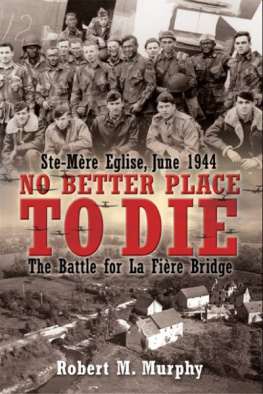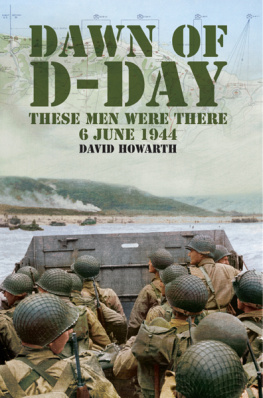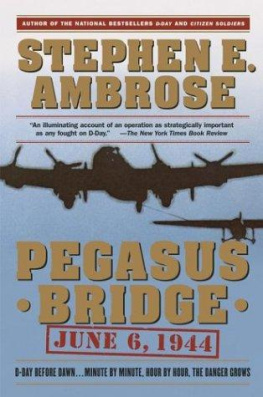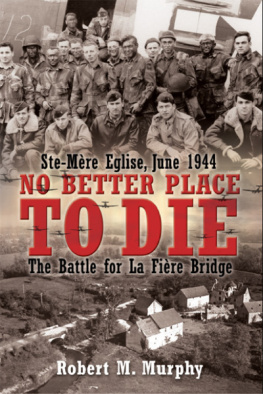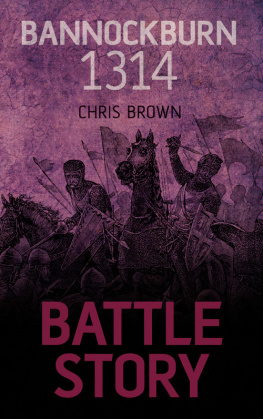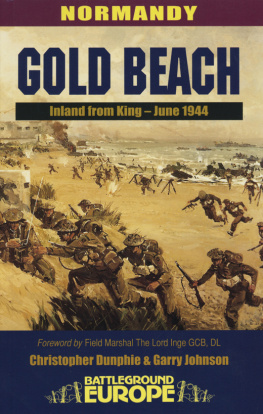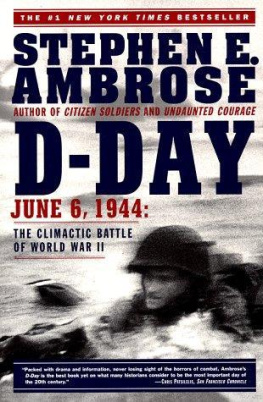

Author Bob Murphy in Ste. Mre-Eglise, where a street is named in his honor.

Published in the United States of America in 2009 by CASEMATE
1016 Warrior Road, Drexel Hill, PA 19026
and in the United Kingdom by CASEMATE
17 Cheap Street, Newbury, Berkshire, RG14 5DD
2009 by Robert M. Murphy
ISBN 978-1-935149-08-8
Cataloging-in-publication data is available from the Library of Congress and from the British Library.
All rights reserved. No part of this publication may be reproduced, stored in a retrieval system or transmitted, in any form or by any means, electronic, mechanical, photocopying, recording or otherwise, without the prior permission of the publishers.
Printed and bound in the United States of America.
10 9 8 7 6 5 4 3 2 1
For a complete list of Casemate titles, please contact
United States of America
Casemate Publishers
Telephone (610) 853-9131, Fax (610) 853-9146
E-mail casemate@casematepublishing.com
Website www.casematepublishing.com
United Kingdom
Casemate-UK
Telephone (01635) 231091, Fax (01635) 41619
E-mail casemate-uk@casematepublishing.co.uk
Website www.casematepublishing.co.uk
C ONTENTS
F OREWORD
B Y M ARK J. A LEXANDER
(C OLONEL , USA, RETIRED )
O UR COUNTRY WAS AT WAR . A FTER years of warfare and planning, the Allied forces were finally poised to mount the Normandy invasion and free Fortress Europa from the Nazi yoke.
In the pre-dawn darkness of June 6, 1944, three Allied Airborne Divisions landed behind enemy lines, two in Normandys Cotentin Peninsula. Their vital mission was to hold off the expected counter-attack by Rommels panzer reserve against the Allied landing beaches. The 82d Airborne Division was assigned the mission of protecting Utah Beach and ensuring the exit from this American beach landing area would be free from enemy attack from the Normandy hinterland to the beaches.
The special mission of the 505th Parachute Infantry Regimental Combat Team (RCT) was to seize the town of Sainte Mre Eglise, with the road and communications network. The RCT consisted of the 505 Parachute Infantry Regiment, the 456 Parachute Field Artillery Battalion, Company B 307 Parachute Engineers, 80th Airborne Antiaircraft Battalion (equipped and acting as an antitank unit) and the 307 Airborne Medical Company. Their task was to prevent enemy forces from crossing the Merderet River and carrying out Rommels plan to destroy the Allied landing on the beaches where it was most vulnerable.

Mark J. Alexander
Low clouds led to the dispersion of the incoming C-47 troop carriers, scattering the parachute drops widely over the Norman landscape. Only the 505th RCT landed with any degree of accuracy, avoiding the movement of individual and small groups seeking their parent units. This extra degree of cohesion was a good thing for the 505. The 1st Battalion, 505 RCT would soon be locked in a life-or-death struggle for control of the vital bridge at La Fire. German panzer and infantry forces struck hard at the defenders time and again. But at no time was the bridge to change hands until the All American soldiers handed it off to the Utah Beach American Relief Land Force, the men of the 357th Infantry Regiment, who headed across the Merderet River on June 9 after the 82d Airborne Division glidermen and paratroopers completely destroyed the enemy troops on the west side of the causeway and river at the Cauquigny church crossroads.
Author and soldier Robert M. Murphy has done a commendable job in collecting numerous accounts from his fellow La Fire combat veterans, the paratroopers and glidermen on the scene at La Fire. No Better Place to Die provides a complete story of these events from the perspective of the combat soldier who was there and fought in those battles.

Plan of the US airborne landing to the rear of Utah Beach
The 82d airborne Division was programmed to jump on drop zones (DZ) N 508 PIR, T 507 PIR and O 505 PIR.
The 101st Airborne Division was programmed to jump on drop zones A, C and D.
The gliders transporting the 325 GIR of the 82d Airborne had to land on LZ W around Les Forges.
Those transporting the glidermen of the 101st airborne had to land on LZ E.
I NTRODUCTION
B Y I AN D AGLISH
C HESHIRE , E NGLAND
W E DRIVE WEST OUT OF A small French town. Passing under the autoroute, we follow a minor road through quiet countryside. Two kilometers on, the hedgerows grow thicker and our road crosses a bridge over a deep cutting with a two-track railway. Suddenly we are in true bocage, the lane winding between high hedgerows. A final bend and the road straightens, sloping down past the Manoir, a large farm on our left. We stop opposite the farm buildings. Ahead, a river meanders slowly, flowing under the stone road bridge. Further ahead, beyond the bridge, our road turns slightly right to follow a raised road traversing 730 meters (750 yards) of open meadows. Through this tree-lined causeway and the hedgerows on the far side of the valley, we can make out the roofs of the houses and small church of the hamlet opposite.

La Fire Manoir today

La Fire bridge, target of the 1st Battalion of the 505 Parachute Infantry Regiment
All is peace and tranquility. We have traveled hundreds of kilometers to visit this site, yet there seems to be nothing remarkable here. The locals, most of them elderly farming folk, are unused to visitors, and stare openmouthed at the historian laden with cameras and cam recorder, taken by surprise and curiosity when he asks permission to film their homes and their farmyards. Casual passers-by would see nothing but quiet, unremarkable French countryside. Unless they stop where we have stopped, and read the small sign over a hole beside the road, marking the foxhole where General Gavin fought on D-Day. Unless they talk to the master of the Manoir, Monsieur Possion, and hear his story and see his cache of antique weaponry. Or unless they come upon the stunning memorial, the Iron Mike statue at La Fire, standing sentinel to the memory of airborne troopers from bygone wars.
Monsieur Poisson ensures that no one is watching, then reaches his arms into the eaves of an old cattle shed. He pulls out an old mine, a grenade, the fossilized bag of a gammon grenade, its stockinette squares now stiff and its contact fuse rusted solid. lt was one such grenade that the first American to approach the Manoir on the morning of June 6 tossed in response to a German sentrys challenge. The German instinctively tried to catch the thrown object, which ended, for the moment, the local rsistance. Perhaps this was one of the grenades carried by men of the misdropped 507 Parachute Infantry Regiment, who crossed the causeway after the battle for the Manoir there, looking for friends, and ran into German tanks. Or maybe this was just one of the many gammon grenades whose owner gradually used up the Composition C plastic explosive charge, lighting tiny pieces to heat his coffee. In any case, the relic is a reminder of the days when this quiet valley was the scene of death and destruction, and a focus of the attention of the whole world.

